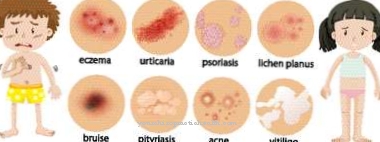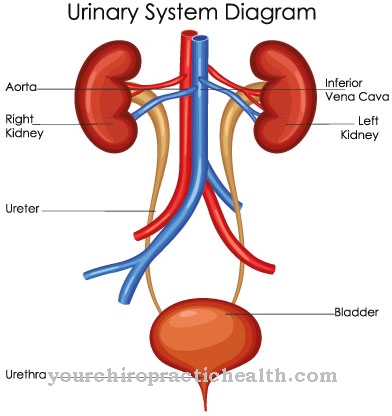At a Ameloblastoma it is a special type of tumor of a locally invasive nature. The name of the tumor is made up of the two Greek terms for 'germ' and 'enamel'. The ameloblastoma starts from the cells that are responsible for the formation of tooth enamel.
What is an ameloblastoma?

The basis for the development of an ameloblastoma are the teeth. In particular, the cells that form tooth enamel are significantly involved in the genesis of ameloblastomas. Basically, the ameloblastoma is an odontogenic tumor that originates in the teeth.
The development of the tumor is related to the tooth anchors that are already present in embryos. These early attachments of the later teeth are divided into an ectodermal and a mesodermal area. Ameloblastomas recur in many patients, but the majority of the cases are benign tumors.
This means that people suffering from ameloblastoma generally do not have to fear the formation of metastases. Only in a few exceptional cases is the ameloblastoma present as a malignant tumor. In principle, the ameloblastoma is differentiated into a plexiform and a follicular disease type.
causes
The exact factors and relationships of the pathogenesis of ameloblastoma are not yet sufficiently known. Various medical studies investigate the causes of the disease. However, so far there are hardly any reliable statements about the development of ameloblastomas.
Symptoms, ailments & signs
The symptoms of ameloblastoma depend on the respective stage of the disease and sometimes vary in individual cases. In numerous cases, the ameloblastoma is discovered only by chance during other medical examinations. The ameloblastoma often appears as a swelling in the area of the jaw, but does not cause any pain. About a third of ameloblastomas are based on follicular cysts.
In the course of the further development of the ameloblastoma, so-called resorption processes occur. As a result, there may be changes in the position of the teeth. These shifts sometimes press certain nerves, so that people suffer from impaired sensitivity. Basically, ameloblastoma is six times more likely to develop in the lower than the upper jaw.
In the lower jaw, the ameloblastoma is often located in the so-called angle of the jaw, while in the upper jaw it often occurs in the area of the canines. In the majority of cases, the ameloblastoma develops between the third and fourth decade of life. In addition, ameloblastoma occurs with approximately the same frequency in female and male patients.
Diagnosis & course
In many cases, the diagnosis of ameloblastoma is made relatively late or by chance. Because at the beginning of the disease, the affected patients hardly feel any pain or other irritations. Only in the further course of the development of the ameloblastoma may the tumor become noticeable through certain signs. For example, it appears increasingly visually or impairs sensitivity.
Patients with corresponding complaints consult their general practitioner, who usually initiates a referral to a specialist. The initial anamnesis informs the attending physician about the symptoms, the time of the first complaints, potentially relevant origins or genetic dispositions. The subsequent clinical examination includes histological analyzes of the ameloblastoma.
In addition, X-ray examinations are usually used to visualize the diseased area of the jaw. In the case of an ameloblastoma, changes in the localization of the teeth can often be seen here. In addition, lightened regions are visible on the jawbone (medical term "osteolysis"). In addition, the patients usually undergo computed tomography.
With regard to the final diagnosis of ameloblastoma, the doctor has to consider a variety of diseases that are sometimes confused with ameloblastoma. For example, the doctor rules out an ameloblastic fibroma, an odonto-meloblastoma, an osteosarcoma, an odontogenic squamous cell tumor, and an ameloblastic fibroodontoma.
In addition, the doctor differentiates the ameloblastoma from an ameloblastic fibrodentinoma, a Pindborg tumor, a follicular cyst of the lower jaw, a radicular cyst of the root tip, a giant cell granuloma and a keratocystic odontogenic tumor. Once the differential diagnosis has been completed, the diagnosis of ameloblastoma is relatively well established.
When should you go to the doctor?
An ameloblastoma needs to be treated by a doctor. If the disease is not treated, the tumor can spread to other parts of the body and cause discomfort or complications. As a rule, the ameloblastoma leads to a reduction or restriction in sensitivity. A doctor should therefore always be consulted if there are sensory disturbances or disturbances to the sensitivity of the jaw or teeth.
Most of the time, these symptoms occur for no particular reason and cannot be linked to a disease or a specific cause. The canines in particular are often affected by these disorders. In many cases, however, the ameloblastoma is discovered during check-ups. The treatment is usually carried out by a dentist or a surgeon. There are no further complaints and the disease can be well limited. Even after treatment, the patient must have regular check-ups so that the tumor can be completely removed.
Doctors & therapists in your area
Treatment & Therapy
The options for treating ameloblastoma are mostly one-way, but are relatively successful for most people. In the majority of cases, the doctors decide that the ameloblastoma should be removed as part of a surgical intervention. A distance of around half a centimeter is maintained to ensure safe removal of the diseased tissue.
After the ameloblastoma has been resected, the jawbone is usually reconstructed during the same operation. Following the surgical procedure, the prognosis for ameloblastoma is comparatively good. However, ameloblastomas show a relatively strong tendency to recur.
For this reason, it is always necessary that the affected patients undergo regular check-ups even after a successful operation. These take place at intervals of six or twelve months and take place over several years. This enables any recurrences of the ameloblastoma to be quickly identified.
Outlook & forecast
In many cases, ameloblastoma treatment is started late because ameloblastoma is diagnosed only by chance or during check-ups. The patients may suffer from a displacement of the teeth, which occurs primarily for no particular reason. This can also lead to pain. Furthermore, those affected also suffer from a sensitivity disorder in the entire oral cavity. Due to this disorder, the intake of fluids and food may be impaired. If this tumor is not treated, the life expectancy of the person affected is significantly reduced and death occurs prematurely.
The treatment itself takes the form of a surgical procedure in which the tumor is removed. As a rule, the ameloblastoma also has to be reconstructed in the jawbone so that the person concerned does not suffer from consequential damage. Life expectancy is not limited with successful and early treatment. In most cases, those affected depend on check-ups even after a successful operation so that the cancer does not develop again or spread to other areas of the body.
prevention
Concrete information on successful preventive measures regarding ameloblastomas is not possible. The causes of the disease are not sufficiently known and risk factors are scarcely researched.
Aftercare
In most cases of ameloblastoma, the patient has no options for follow-up care. The person concerned is always dependent on treatment, and without treatment, the person concerned usually dies. The removal of the tumor is carried out with the help of a surgical procedure.
There are usually no particular complications and the disease progresses positively. After the procedure, the person affected should rest and take care of their body. Sports activities or other strenuous activities are therefore not recommended after the procedure. Likewise, solid food must not be consumed immediately after the procedure in order to protect the oral cavity.
Furthermore, in the case of ameloblastoma, after the tumor has been removed, regular antibiotics must be taken to avoid inflammation and other complaints. Even after a successful removal, regular check-ups should still be carried out in order to discover and remove further tumors at an early stage.
This is the only way to guarantee a normal life expectancy for the patient. In some cases, contact with other sufferers of ameloblastoma can also be helpful, as this leads to an exchange of information that can make everyday life easier.
You can do that yourself
If an ameloblastoma has been diagnosed, those affected should inform themselves well about the tumor disease. Educational discussions with the doctor and a psychosocial cancer counseling center reduce the uncertainties and fears. Measures such as sport, dancing, painting or singing help to reduce feelings of pain, anger and despair and thereby also reduce internal tension.
The actual pain experience can also be alleviated through relaxing activities. Relaxation techniques from yoga or quigong also support recovery by strengthening the immune system. Cancer patients can usually fall back on special therapeutic offers in order to take action against the symptoms in addition to conservative cancer therapy.
Eating a healthy diet is just as important. The diet should consist of plenty of fruits and vegetables, as well as fish and poultry. Red meat from pork or beef should be avoided in ameloblastoma as it can further strain the blood vessels. At best, the food is freshly prepared so that as many vitamins as possible are retained.
Whether alternative therapies make sense has to be decided individually. Ameloblastoma patients should consult with the responsible doctor and take the right measures to optimally promote recovery and improve well-being. In the event of a difficult course, advance directives and other organizational matters should be arranged at an early stage.




.jpg)

.jpg)






.jpg)

.jpg)
.jpg)











.jpg)